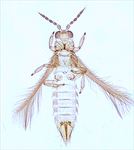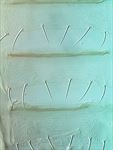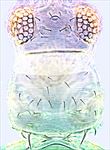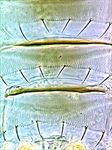
dobrowski female

dobrowski antenna

dobrowski head & pronotum

dobrowski tergites VI-IX

dobrowski sternites V-VII

dorsalis head & pronotum

dorsalis sternites V-VII
Generic diagnosis
Female macropterous. Head wider than long, with closely spaced transverse striae, interantennal projection broad; maxillary palps 3-segmented; eyes sometimes with pigmented facets; ocellar setae I present; setae III short and variable in position; one to five pairs of postocular setae. Antennae 8-segmented (rarely 7); segment I without paired dorso-apical setae, II with one inner dorsal apical setae longer than outer seta, with rows of microtrichia dorsally, III and IV with sense-cones forked, III–VI with rows of microtrichia on both surfaces. Pronotum with closely spaced transverse striae; four (rarely five) pairs of posteromarginal setae, S2 setae variably elongate and sometimes interpreted as long "posteroangular setae". Mesonotum with transverse striae; median pair of setae situated far from posterior margin; campaniform sensilla absent. Metanotum variably reticulate; median pair of setae situated at or behind anterior margin; campaniform sensilla absent. Fore wing first vein with setal row variable but incomplete; second vein with one to eight setae; clavus with three or four veinal and one discal setae; posteromarginal fringe cilia wavy or straight. Prosternal ferna weakly divided medially; basantra membranous, without setae; prospinasternum narrow and curved posteriorly medially. Mesosternum with sternopleural sutures weak, reaching anterior margin; endofurca with spinula. Metasternal endofurca with spinula. Tarsi 2-segmented. Tergites without ctenidia or craspeda, not clearly divided from laterotergites, S1 setae variable in position, close to or wide apart; tergites II–VIII lateral thirds with closely spaced rows of microtrichia, II–VII with posteromarginal microtrichia laterally; VIII with comb long, fine, complete; IX without campaniform sensilla; X without median split. Sternites with microtrichial fields at least laterally, without discal setae or craspeda; sternites III–VII with three pairs of marginal setae, II with two pairs.
Male similar to female; tergite IX often with pair of drepanae curving dorsally; sternites without pore plates.
Biological data
The members of this genus all feed and breed on leaves, usually on young leaves but also on the surface of very young fruits including oranges, avocadoes and mangos. Several species are known as serious pests, particularly of fruit trees including Citrus [Rutaceae], Mangifera [Anacardiaceae] and Persea [Lauraceae].
Distribution data
Species of Scirtothrips are found widely across the warmer parts of the world.
Nomenclatural data
Scirtothrips Shull, 1909: 222. Type species Scirtothrips ruthveni Shull, 1909, by monotypy.
About 100 species are listed in this genus (ThripsWiki, 2020), with the following eight recorded from China:
acus Wang, 1994: 2.
asinus Wang, 1994: 4.
dobroskyi Moulton, 1936: 264.
dorsalis Hood, 1919: 90.
ginkgoe Mirab-balou Tong & Chen, 2012: 2.
hainanensis Han, 1986: 108.
hengduanicus Han, 1990: 123.
pendulae Han, 1986: 109.
Relationship data
Thripidae sub-family Thripinae: this is a diverse group involving more than 230 genera. This genus is the largest of the 11 genera recognised in the Scirtothrips genus-group (Ng & Mound, 2015). The included species include most of the Thripinae that have closely spaced rows of microtrichia laterally on the tergites.
References
Mirab-balou M, Tong XL & Chen XX (2012) A new species of Scirtothrips infesting Ginkgo biloba in eastern China. Journal of Insect Science 12 (117): 1–7.
Ng Y F & Mound LA (2015) Genera of the Scirtothrips genus-group (Thysanoptera, Thripidae) with a new species of Siamothrips from Malaysia. Zootaxa 4021 (2): 387–394.
ThripsWiki (2020). ThripsWiki - providing information on the World's thrips. <http://thrips.info/wiki/Main_Page>
Wang CL (1994) The species of Scirtothrips (Thysanoptera: Thripidae) of Taiwan. Journal of the Taiwan Museum 47: 1–7.